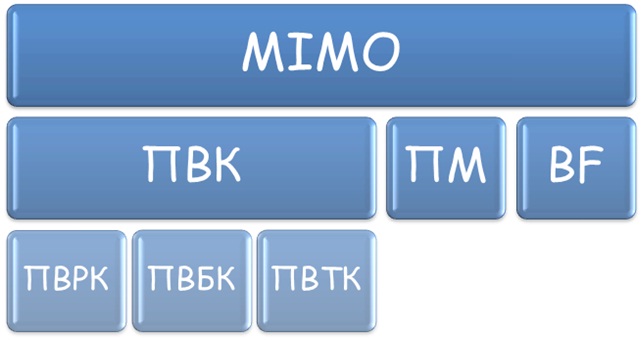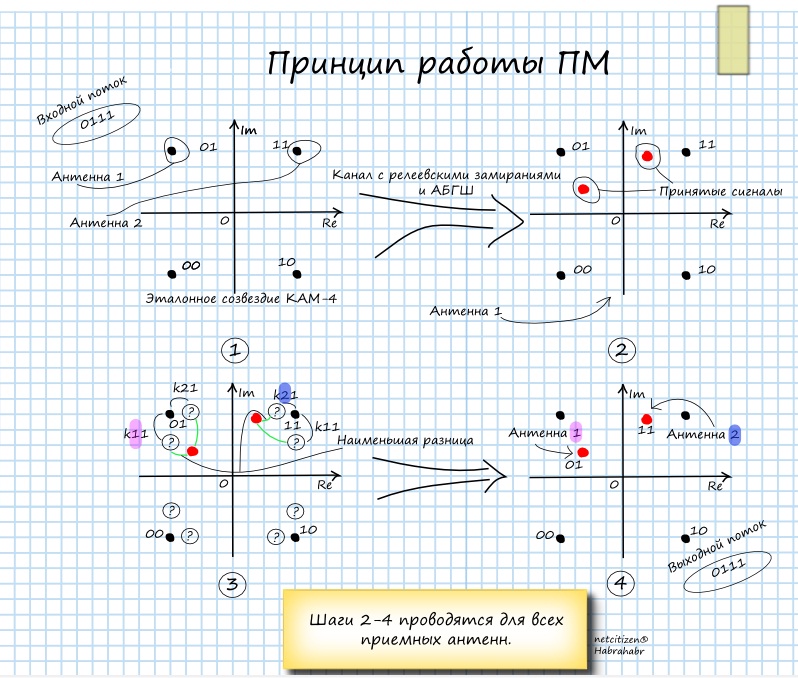Spatial multiplexing: just about complicated. Part 1

The breakthrough of recent years in the field of wireless standards and communication technologies is obliged, in fact, to a single technology - MIMO. In the article I will try to explain how the speed increases when using multi-antenna systems and I will try to describe the principle of operation of MIMO-OFDM systems without complicated formulas and diagrams.
As an introduction, I would like to recommend that you familiarize yourself with the work of comrade tgx , where it is very beautifully explained what OFDM is, some concepts from communication theory are given.
Without getting into specific terms briefly, the properties of a communication system can be described by two points: noise immunity (PU) and throughput (PP). In spite of the fact that today we all measure speeds with transmissions (throughput - the maximum speed provided by the communication system) it is the transmission reliability that is at the forefront (indicator: probability of error). In any system there is always a mechanism for the exchange of PP on PU. That is why with a sharp deterioration in the conditions of transmission (you left with the laptop from the office to the kitchen) you get in your browser not krakozyabry (although most likely you will not see them), but notice a decrease in speed.
Not so long ago, the main way to squeeze the coveted decibels was to improve the signal-code designs and methods of error-correcting coding. MIMO did the seemingly impossible: without changing the frequency band, signal energy, only by physically increasing the number of antennas and complicating the processing methods, it was possible to increase the theoretical PC and PU of communication systems several times. It so happened that there is practically no normal literature in Russian, the author had to deal with the processing of English-language literature.
Classification of MIMO systems
It would be logical to separate MIMO systems as systems with many inputs and many outputs according to the type of use of this spatial redundancy.

I tried to reveal the topic of the PWC here .
BF (Beamforming-beamforming) - the prospect of the development of MIMO systems. The point is to use the CAR (Digital Antenna Grid), which allows you to dynamically change the pattern. How can this be applied? The formation of several rays is an imitation of a multi-antenna system, i.e. There is no need to fence a garden from classical antennas. Automatic adjustment to the location of the receiver allows you to give more energy to the receiver and therefore increase the PU and as a result of PP.
Spatial Multiplexing
Mathematically, the signal at the receiver after passing through the radio channel is the sum of the product of the original signal and some complex transfer function (QPF) and noise. Conditional fading arising in the radio channel is exactly what makes up the CPP. The distribution law of the CPP, as a random variable, determines the presence of direct visibility between the transmitter and the receiver and the factors affecting the multipath propagation of the signal (walls in an apartment, a house in the city, etc.) .
Since there are several antennas in the system, the paths traveled by signals from different antennas are also different, therefore their CPF will be different for each transmitter-receiver pair. This is a crucial point. Based on the structure of the KPF system, all its subchannels can be reduced to a matrix.
And now the fun part. It turns out that each channel has its own characteristics that are different from its neighbors, therefore the signal transmitted through it can be clearly separated from signals transmitted through other channels transmitted in the same frequency band.
MIMO mathematics, namely, the decision-making algorithms are rather complicated, but they are all based on the knowledge of the CPP on the receiving side. But how to implement it, if at a certain frequency we transmit information, and this is a random variable? The most effective solution is to introduce pilots into the signal structure — signals with previously known parameters that can be used to estimate the channel.
')
Channel rating
OFDM technology is unique, in addition to excellent performance of EEE (frequency-energy efficiency), unprecedented noise immunity (not to be confused with noise immunity) and flexibility, it fits in perfectly with the MIMO concept. An OFDM structure is a set of modulated subcarriers located at a fixed distance from each other in the frequency spectrum.
Due to the fact that real channels are frequency selective (CPP even of neighboring subcarriers may have a big difference), some of the subchannels are used for channel estimation purposes. For this pilot subcarriers are modulated by FM-2 (Phase modulation with positionality 2, allows to transmit 1 bit) with a pseudo-random sequence known at reception. The choice of the location of these subcarriers is also not accidental: it takes into account the uniformity of their distribution in the private and time domain (causes in various types of interference).

On the receiving side, the pattern of the pilot carrier is divided into the accepted variant, and as a result, we get a channel KPF for the pilot carrier. Next is the approximation of the obtained values for the information subchannels.
The goal has been achieved: the channel CPP is found for all subcarriers and you can return to MIMO.
Signal processing
There are a large number of methods for processing the received signal, but the simplest and the most resource-intensive is ML (Maximum Likehood).
The decision on the received signal is made according to the minimum difference between the calculated signal value and the brute force adopted by the implementation for all subchannels and possible signals.

The presented algorithm is quite simplified, however, it allows you to visually explain "where did the speed come from" and how "the receiver understands which signal from which antenna came".
Conclusion
In fact, the material presented in this article is the tip of the iceberg. The ML algorithm is not used in practice, as it requires a lot of resources. The spherical decoding algorithm has become a significant improvement. Modern communication systems are confidently moving towards the adaptability of the speed of error-correcting codes, the positioning of modulation, beamforming and the rate of spatial coding. All these methods squeeze the radio channel to the maximum. On the subject of spatial processing, the idea of singular processing (precoding) of a signal together with the use of a “water-filled” solution based on a well-known channel estimate on the transmission seems very promising to me.
Literature
- Alain Sibille, Claude Oestges, Alberto Zanella "MIMO: From Theory to Implementation"
- Yong Soo Cho, Jaekwon Kim, Won Young Yang, Chung G. Kang "MIMO-OFDM Wireless Communications with MATLAB"
Source: https://habr.com/ru/post/150362/
All Articles